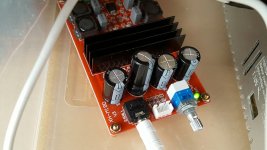You'd have to look at the board but the caps are probably a "bank" or 2 banks each feeding a chip-amp.
It really shouldn't hiss. Depends on your speaker sensitivity and maybe if you use the on/off volume or always run it 100%, Has been some discussion about badly matched cheap pots on this sub-forum.
It really shouldn't hiss. Depends on your speaker sensitivity and maybe if you use the on/off volume or always run it 100%, Has been some discussion about badly matched cheap pots on this sub-forum.
Maybe they fitted fake caps which didn't really have the voltage spec which is marked on them. If I were you I'd fit some Nichicon/Samyoung/NCC which are verifiably the parts in those manufacturers' datasheets in physical dimensions. Go for parts with lowest ESR.
Hi,
Also, I would check the voltage to see if the capacitors voltage rating are right/correct for the amp working voltage.
Also, I would check the voltage to see if the capacitors voltage rating are right/correct for the amp working voltage.
Most probably they get hot due to hi-ESR and actual ripple current. Replace by some quality low-ESR-types.
What ripple current? I mean, this is 2 caps per 3116.
Maybe these caps are "dry by design" and reused 25V parts - who knows.
Measuring leakage will tell.
Maybe these caps are "dry by design" and reused 25V parts - who knows.
Measuring leakage will tell.
Last edited:
Poor quality of capacitors,high currents passed around and high temperatures have put an end to that capacitor.Replace it with a low ESR type capacitor with a larger value,if you like.
Probably just cheap caps. Temperature and ripple current affect lifetime, but good quality caps should just die quietly and lose capacitance.
Going Boom! Means underated or poor quality.
There should not be much ripple current with a DC supply. The caps just take out the little pulse when the bass kicks in and maintain supply voltage.
If you have some horrible ultrasonic hissy loop and are actually burning many amps you can't hear, that may explain blown caps. Other things would be getting hot too and you'd notice?
Cheap caps I reckon.
Going Boom! Means underated or poor quality.
There should not be much ripple current with a DC supply. The caps just take out the little pulse when the bass kicks in and maintain supply voltage.
If you have some horrible ultrasonic hissy loop and are actually burning many amps you can't hear, that may explain blown caps. Other things would be getting hot too and you'd notice?
Cheap caps I reckon.

I had a blown cap on a cheap black TDA7498 once.
It was a bigger mess than what you have and the amp got destroyed.
Desolder all of that trash it might harm your health and your equipment.
It was a bigger mess than what you have and the amp got destroyed.
Desolder all of that trash it might harm your health and your equipment.
There should not be much ripple current with a DC supply.
Have you heard about ClassD? High current can flow on an inductor without much heat. Do we know any detail about the board? It's red and "dual chip". Wonderful. What about usage, power suply, load, heating, output inductor, switching frequency, etc...? Based on the given informations can you say anything about the current? Then you must be the engineer designed the board!
Steady!
A capable PSU should maintain the volts under varying loads. The caps on the board should just be taking out the spikes. They are not being used in a heavy duty way from a diode rectifier at 50hz.
Granted HF will heat caps faster than LF. But unless there is some horrible oscillation going on, those spikes on class D should not be that bad. The design is by the OE. They recommend cap types and capacities.
I have only a limited experience based on 30 years of industrial inverters and similar for semiconductor design and home electronics. So I'm only starting out at this.
Why would a cap blow up on a switching amp unless it was under rated or there was some sort of oscillation?
My comment about other parts heating giving a clue still stands and so does my conclusion is that the caps are not up to scratch
A capable PSU should maintain the volts under varying loads. The caps on the board should just be taking out the spikes. They are not being used in a heavy duty way from a diode rectifier at 50hz.
Granted HF will heat caps faster than LF. But unless there is some horrible oscillation going on, those spikes on class D should not be that bad. The design is by the OE. They recommend cap types and capacities.
I have only a limited experience based on 30 years of industrial inverters and similar for semiconductor design and home electronics. So I'm only starting out at this.
Why would a cap blow up on a switching amp unless it was under rated or there was some sort of oscillation?
My comment about other parts heating giving a clue still stands and so does my conclusion is that the caps are not up to scratch

Last edited:
Both boards have been running from an smps, with my TV's headphone output. Smps measures a steady 23.8VDC even under "load". Both boards have not been beyond medium volume. So yeah. Bad caps! Wrote a complaint to the ebay seller. I know this is an "easy fix" but still - They should work out of the box in non stressing circumstances.
- Status
- Not open for further replies.
- Home
- Amplifiers
- Class D
- Caps blew up...
